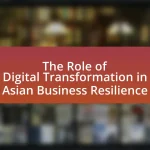The article examines the critical role of language in facilitating cultural exchange at Asian business events. It highlights how effective communication through various languages, including Mandarin Chinese, English, Japanese, Hindi, and Korean, enhances networking opportunities and collaboration among diverse participants. The discussion includes the impact of language barriers on business interactions, the importance of cultural understanding in negotiations, and strategies for overcoming communication challenges. Additionally, it explores the benefits of cultural exchange for businesses, emphasizing the need for multilingual communication and the use of technology to improve language proficiency and foster successful international partnerships.

What is the Role of Language in Cultural Exchange at Asian Business Events?
Language serves as a crucial medium for cultural exchange at Asian business events by facilitating communication and understanding among diverse participants. Effective language use enables attendees to share ideas, negotiate deals, and build relationships, which are essential for successful business interactions. For instance, English often acts as a lingua franca in these settings, allowing individuals from different linguistic backgrounds to engage meaningfully. Research indicates that language proficiency can significantly impact networking opportunities and collaboration outcomes, highlighting its importance in fostering cross-cultural connections.
How does language facilitate communication in Asian business contexts?
Language facilitates communication in Asian business contexts by serving as a crucial tool for conveying ideas, building relationships, and negotiating deals. In diverse Asian markets, where multiple languages and dialects coexist, effective communication relies on a shared understanding of language nuances, cultural references, and business etiquette. For instance, in countries like China and Japan, the use of formal language and honorifics reflects respect and hierarchy, which are essential in business interactions. Research indicates that companies that invest in language training for their employees experience improved collaboration and increased success in negotiations, as evidenced by a study from the British Council, which found that 75% of businesses reported enhanced performance when employees could communicate effectively in the local language. Thus, language not only facilitates clear communication but also fosters trust and mutual respect in Asian business environments.
What are the key languages spoken at Asian business events?
The key languages spoken at Asian business events include Mandarin Chinese, English, Japanese, Hindi, and Korean. Mandarin Chinese is the most widely spoken language in Asia, reflecting China’s significant economic influence. English serves as a global lingua franca, facilitating communication among diverse participants. Japanese is crucial in industries like technology and automotive, while Hindi is increasingly important due to India’s growing market. Korean is relevant in sectors such as electronics and entertainment, particularly with South Korea’s economic prominence. These languages are essential for effective communication and networking in the context of Asian business events.
How do language barriers impact networking opportunities?
Language barriers significantly hinder networking opportunities by limiting effective communication among individuals from different linguistic backgrounds. When participants cannot understand each other, they struggle to share ideas, collaborate, and build relationships, which are essential components of networking. A study by the British Council found that 75% of professionals believe that language skills are crucial for career advancement, highlighting the importance of effective communication in networking contexts. Additionally, language barriers can lead to misunderstandings and misinterpretations, further complicating interactions and reducing the likelihood of forming valuable connections.
Why is cultural exchange important at Asian business events?
Cultural exchange is important at Asian business events because it fosters mutual understanding and collaboration among diverse participants. This exchange allows businesses to navigate cultural nuances, which can significantly impact negotiations and partnerships. For instance, understanding local customs and communication styles can enhance relationship-building, leading to more successful business outcomes. Research indicates that companies engaged in cross-cultural interactions are 1.5 times more likely to achieve their objectives compared to those that do not prioritize cultural awareness. Thus, cultural exchange not only enriches the business environment but also drives economic growth and innovation in the region.
What are the benefits of cultural exchange for businesses?
Cultural exchange benefits businesses by enhancing innovation, improving market understanding, and fostering international partnerships. By engaging in cultural exchange, companies gain diverse perspectives that can lead to creative solutions and new product ideas. For instance, a study by the McKinsey Global Institute found that diverse teams are 35% more likely to outperform their competitors, highlighting the value of varied cultural insights. Additionally, cultural exchange helps businesses understand local consumer behaviors and preferences, which is crucial for tailoring products and marketing strategies effectively. This understanding can lead to increased customer satisfaction and loyalty. Furthermore, cultural exchange facilitates networking opportunities, allowing businesses to establish valuable connections in foreign markets, ultimately driving growth and expansion.
How does cultural understanding enhance collaboration?
Cultural understanding enhances collaboration by fostering effective communication and reducing misunderstandings among diverse team members. When individuals appreciate and respect different cultural perspectives, they are more likely to engage in open dialogue, share ideas freely, and work towards common goals. Research indicates that teams with high cultural awareness demonstrate improved problem-solving abilities and creativity, as they leverage varied viewpoints to generate innovative solutions. For instance, a study published in the Journal of International Business Studies found that culturally diverse teams outperform homogeneous teams in complex tasks due to their ability to integrate diverse knowledge and approaches.

What challenges arise from language differences in Asian business events?
Language differences in Asian business events create significant challenges, including miscommunication, misunderstandings, and reduced collaboration. These challenges arise because diverse languages and dialects can lead to varying interpretations of messages, which may result in confusion during negotiations or presentations. For instance, a study by the Asian Development Bank highlights that language barriers can hinder effective communication and limit the ability to build trust among business partners. Additionally, the lack of proficiency in a common language, such as English, can restrict participation and engagement, ultimately affecting the success of the event.
How do miscommunications occur due to language differences?
Miscommunications occur due to language differences primarily because of variations in vocabulary, grammar, and cultural context. When individuals from different linguistic backgrounds interact, they may interpret words and phrases differently, leading to misunderstandings. For instance, idiomatic expressions that are common in one language may not have direct equivalents in another, causing confusion. Additionally, differences in sentence structure can result in ambiguity, where the intended meaning is lost. Research indicates that approximately 70% of cross-cultural communication failures stem from language barriers, highlighting the significant impact of language differences on effective communication in diverse settings, such as Asian business events.
What are common examples of miscommunication in business settings?
Common examples of miscommunication in business settings include language barriers, cultural misunderstandings, and unclear messaging. Language barriers occur when individuals do not share a common language or proficiency level, leading to misinterpretation of information. Cultural misunderstandings arise when different cultural norms and practices influence communication styles, resulting in unintended offense or confusion. Unclear messaging happens when information is not conveyed in a straightforward manner, causing recipients to misinterpret the intended message. These examples highlight the importance of effective communication strategies in diverse business environments.
How can businesses mitigate the risks of miscommunication?
Businesses can mitigate the risks of miscommunication by implementing clear communication protocols and utilizing professional translation services. Establishing standardized communication guidelines ensures that all employees understand the expectations and processes, reducing ambiguity. Additionally, employing professional translators or interpreters during meetings and events can bridge language gaps, as studies show that effective translation significantly enhances understanding in multicultural settings. For instance, a report by the International Association of Conference Interpreters indicates that accurate interpretation can improve participant satisfaction by up to 30%, highlighting the importance of clear communication in diverse business environments.
What strategies can be employed to overcome language barriers?
To overcome language barriers, employing strategies such as utilizing translation technology, hiring bilingual staff, and providing language training can be effective. Translation technology, including apps and devices, facilitates real-time communication, allowing participants to engage without significant delays. Hiring bilingual staff ensures that there are individuals present who can bridge communication gaps, enhancing understanding and collaboration. Additionally, providing language training for employees fosters a more inclusive environment and equips them with essential skills to interact effectively in diverse settings. These strategies are supported by research indicating that effective communication enhances business relationships and cultural exchange, particularly in multicultural environments like Asian business events.
How can translation services enhance communication?
Translation services enhance communication by bridging language barriers, allowing individuals from different linguistic backgrounds to understand each other effectively. These services facilitate accurate and nuanced exchanges of information, which is crucial in multicultural settings such as Asian business events. For instance, a study by the European Commission found that 56% of businesses reported improved international collaboration due to effective translation, highlighting the role of translation in fostering partnerships and negotiations across diverse cultures.
What role do interpreters play in facilitating discussions?
Interpreters play a crucial role in facilitating discussions by bridging language barriers between participants who speak different languages. They ensure that all parties can communicate effectively, allowing for the exchange of ideas, negotiation, and collaboration. For instance, in Asian business events, interpreters enable seamless dialogue by providing real-time translation, which enhances understanding and fosters relationships among diverse stakeholders. This function is supported by the fact that effective communication is essential for successful business outcomes, as evidenced by studies showing that misunderstandings due to language differences can lead to failed negotiations and lost opportunities.

How can businesses leverage language for successful cultural exchange?
Businesses can leverage language for successful cultural exchange by employing multilingual communication strategies that facilitate understanding and collaboration among diverse stakeholders. By providing translation services and hiring bilingual staff, companies can ensure that language barriers do not hinder effective interaction. For instance, research indicates that organizations that utilize multilingual marketing see a 1.5 times increase in customer engagement, demonstrating the importance of language in fostering relationships. Additionally, hosting events with language-specific sessions allows businesses to cater to various cultural groups, enhancing participation and inclusivity. This approach not only promotes cultural appreciation but also drives business growth in multicultural environments.
What best practices should businesses adopt for effective communication?
Businesses should adopt clear and concise messaging as a best practice for effective communication. This involves using straightforward language, avoiding jargon, and ensuring that the intended message is easily understood by all stakeholders. Research indicates that effective communication can enhance collaboration and reduce misunderstandings, which is crucial in culturally diverse environments such as Asian business events. For instance, a study by the Harvard Business Review found that organizations with strong communication practices are 50% more likely to report higher employee engagement and productivity. Therefore, prioritizing clarity in communication not only fosters better relationships but also drives business success.
How can businesses train employees in cross-cultural communication?
Businesses can train employees in cross-cultural communication by implementing structured training programs that focus on cultural awareness, language skills, and practical communication strategies. These programs can include workshops led by experts in intercultural communication, role-playing scenarios to practice real-life interactions, and online courses that provide foundational knowledge about different cultures. Research indicates that companies with effective cross-cultural training see a 30% increase in employee engagement and collaboration in diverse teams, highlighting the importance of such training in enhancing workplace dynamics and productivity.
What tools can assist in language learning for business professionals?
Language learning tools that assist business professionals include language learning apps, online courses, and language exchange platforms. Apps like Duolingo and Babbel offer structured lessons tailored for business vocabulary and scenarios, making them effective for professionals. Online courses from platforms such as Coursera and Udemy provide comprehensive language training with a focus on business communication skills. Additionally, language exchange platforms like Tandem and HelloTalk connect learners with native speakers, facilitating real-world practice and cultural exchange, which is crucial in the context of Asian business events. These tools enhance language proficiency, enabling better communication and cultural understanding in professional settings.
What are the future trends in language use at Asian business events?
Future trends in language use at Asian business events indicate a growing emphasis on multilingualism and the integration of technology in communication. As businesses expand across borders, the demand for simultaneous translation services and multilingual materials is increasing, reflecting the diverse linguistic landscape of Asia. For instance, events are likely to feature real-time translation apps and AI-driven tools to facilitate communication among participants from various linguistic backgrounds. This trend is supported by the rise of international trade agreements and collaborations, which necessitate effective communication strategies that accommodate multiple languages. Additionally, the use of local dialects and languages is expected to enhance cultural sensitivity and foster stronger relationships among business partners, as evidenced by the increasing number of companies adopting localized marketing strategies.
How is technology shaping language exchange in business contexts?
Technology is significantly shaping language exchange in business contexts by facilitating real-time communication and providing access to translation tools. Platforms like video conferencing and instant messaging enable multilingual interactions, allowing businesses to connect with global partners seamlessly. Additionally, translation software and applications, such as Google Translate, enhance understanding by converting languages instantly, which is crucial in negotiations and collaborations. According to a study by the European Commission, 56% of businesses reported that technology-driven language solutions improved their international communication, demonstrating the effectiveness of these tools in fostering cross-cultural exchanges.
What emerging languages should businesses consider in Asia?
Businesses in Asia should consider emerging languages such as Vietnamese, Thai, and Bahasa Indonesia. These languages are gaining prominence due to the rapid economic growth and increasing market potential in their respective countries. For instance, Vietnam’s economy has been one of the fastest-growing in Southeast Asia, with a GDP growth rate of around 6.5% in recent years, making Vietnamese a valuable language for business engagement. Similarly, Thailand’s strategic location and its role as a regional hub for trade and tourism highlight the importance of Thai. Furthermore, Indonesia, as the largest economy in Southeast Asia, has a growing consumer market, making Bahasa Indonesia essential for businesses looking to expand in the region.
What practical tips can enhance language use in cultural exchanges?
Practical tips to enhance language use in cultural exchanges include actively learning key phrases in the local language, utilizing translation apps for real-time communication, and engaging in active listening to understand cultural nuances. Learning key phrases fosters rapport and shows respect for the local culture, which can lead to more meaningful interactions. Translation apps, such as Google Translate, facilitate immediate communication, reducing misunderstandings. Active listening allows participants to grasp context and tone, which are crucial in cross-cultural settings. These strategies are supported by research indicating that effective communication significantly improves relationship-building in international business contexts.




